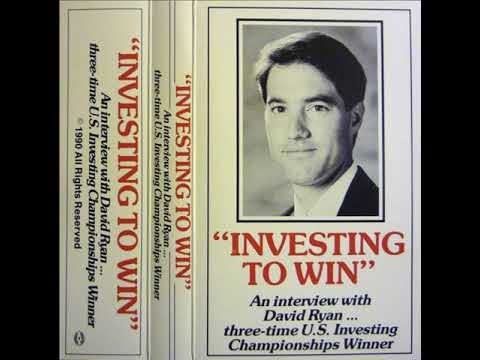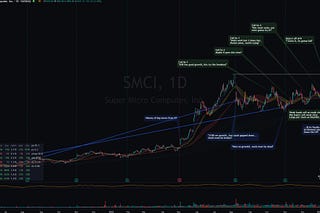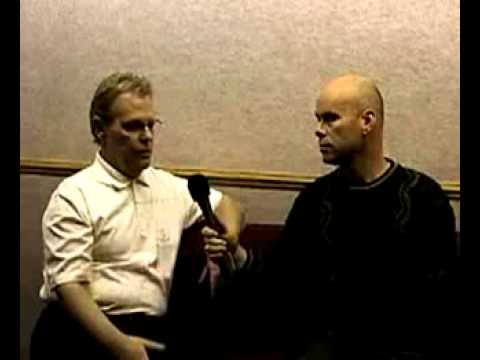

Discover more from The Trading Resource Hub
CAN SLIM — The Timeless Characteristics of Winning Stocks
How David Ryan's and William O'Neil's teachings apply in today's markets
It’s fascinating to see how little has changed for David Ryan over a time span of more than three decades, as is evident from his 1990 interview Investing to Win, all the way through to interviews and videos of him from recent years.
In my previous two stacks, I’ve talked about two of David’s keys to success from a mindset perspective: humility and curiosity.
Today, I’m focusing on the characteristics of winning stocks, as taught to David by William O’Neil: CAN SLIM. David goes over each letter very clearly in the first part of this 1990 interview:
Today’s notes recap the CAN SLIM characteristics, as explained by David in this interview, and discuss how they apply in today’s markets, with help from more recent teachings from Qullamaggie, Dan Zanger and Dr. Mansi.
Timeless characteristics
To repeat a quote from David Ryan from part 1 of this stack series:
“I think what [O’Neil] laid down, and the characteristics he originally found, is really the truth of […] how the market works.
“So, there’s so many parallels between what [O’Neil’s] discovered and what God laid down[:] this is how stocks operate. If a company has […] a great product, they’re going to have great earnings, people are going to want to own that company, and the stock price is going to go up.
“I don’t know how that’s going to change, unless there are [taxes] that clamp down on entrepreneurship, and we don’t have any new products, and nothing new is made.”
Because these characteristics are “the truth of […] how the market works”, whatever the decade, David has been able to maintain his core principles throughout his career, with obviously a great deal of success.
In case you need reminding, David won three consecutive US Investing Championships in 1985–1987, with a compounded return of 1,379% — the understandable title of his TraderLion interview (which is where the above quote comes from).
David has also pointed out that charts from big winners from before his time show the exact same characteristics as the big winners from today — something that also cropped up in, for example, Qullamaggie’s Chat With Traders interview.
The bottom line is that history keeps repeating itself. As David (and many other traders) say, the only thing that’s different is the name at the top of the chart — though, as ever, it’s important you verify this for yourself so you can build your own conviction.
‘C’ and ‘A’: current and annual earnings
Despite the order of the letters in the CAN SLIM acronym, David prefers to start with the ‘A’ — annual earnings.
He likes to see a five-year growth record of at least 25% growth per year, but the higher, the better. (He looks at five years because that covers a normal economic cycle, so if a company can continue to grow in a slow period, then you know it’s got a good product or service.)
He also wants to make sure that the company is continuing to grow, so also looks at the ‘C’ — current earnings. David wants to see at least 25% earnings growth in the two most recent quarters, but again, the stronger, the better.
Is this still applicable for today’s market?
I believe the principles of it are, yes.
Sure, we’ve seen market leaders that lacked earnings entirely. But they often had good sales numbers. At the very least, they had a big story. Either way, the market’s expectation was that the big earnings would follow.
To repeat part of the earlier quote from David, with emphasis added:
“If a company has […] a great product, they’re going to have great earnings, people are going to want to own that company, and the stock price is going to go up.”
‘N’: something new
The ‘N’ in CAN SLIM stands for ‘new’. In the 1990 interview, David explained that this can be a new product or service, or new highs — provided that it’s also coming out of a good base, of course.
However, recognise that not all new highs are equal — a new 26-week high isn’t as good as a new 52-week high, which in turn isn’t as good as a new multi-year high.
In short: the longer the time frame, the better, because this reduces the overhead supply. As such, the best of all is a new all-time high (ATH), as there is no overhead supply. If everybody is at a profit, everybody is happy, and you’ll see far less resistance.
With that in mind, you want to buy a stock (with the right characteristics) just as it’s starting to make that first new high.
To many people, particularly if you’re new to trend following, that’s counterintuitive. In most other walks of life, we’ve been trained to look for a bargain — buy low, sell high. But the fact of the matter is that if a stock is going to make a meaningful move — say, from $25 to $150 — it’s got to make a lot of new highs in the process.
“if a stock is going to make a meaningful move — say, from $25 to $150 — it’s got to make a lot of new highs in the process”
David also shared an example from 1981, about video recorders. He read that video recorders were going to outsell TVs by about two to one in the coming years, so he set about finding a company that either sells or makes video recorders. However, he also wanted to avoid big companies like Sony, where video recorders would have a limited impact on the company’s overall earnings.
As is so often the case in these types of situations, David ended up finding a company he’d never heard of: Wards Company (now Circuit City Corporation). This company sold electronic products, including video recorders, and had the CAN SLIM characteristics. Since the early 1980s, the stock made around a 1,000% gain. David didn’t hold it through the whole move, but made decent gains.
Is this still applicable for today’s market?
Absolutely! Particularly the part about how stocks have to be making a lot of new highs (on some meaningful time frame — not necessarily a new ATH, but the longer, the better) if they’re going to make a big move. That remains applicable no matter the century.
The other part that remains true is looking for new products or services. One of the main O’Neil lessons that has stuck with me personally is that the biggest winners are often the companies that change the way we live, work or play.
Consider the two big themes Qullamaggie discussed during the 1 December 2023 stream: AI and weight loss drugs (GLP-1). Both are new, with the capability of making big change to the way we live and, in AI’s case, the way we work and play.
‘S’: shares outstanding
David explained in his 1990 interview that, from the study that he and O’Neil did, the greatest winning stocks had about 5 million shares outstanding at the start of their move. In practical terms, that typically meant small or medium-sized growth companies.
He also acknowledged that in the market at the time (1990), this number is higher — you’re looking for companies with under 30 million shares outstanding. Again, that reflects the small and medium-sized growth companies of that time.
Importantly, as David pointed out, you want to avoid companies with more than 100 million shares outstanding (remember: these are 1990 numbers), as those are associated with big, mature companies. It just takes a lot of money and power to make a big move compared to smaller companies.
Bottom line: look for smaller caps, with fewer shares outstanding.
Liquidity
In the 1990 interview, David also made a point about looking at the liquidity: how many shares a day does that stock trade on average?
To establish this, check the average daily volume. Is volume increasing or decreasing compared to the previous 5 or 6 weeks? In other words, is demand picking up or dropping off for that stock?
As the stock’s price moves higher, you also want to see an increase in volume, especially when the stock is going into new high ground. Concretely, David is looking for at least a 50% increase compared to the average daily volume.
This point about looking at the volume crops up in virtually every trader I write about, although the specific numbers differ. For instance, Dan Zanger said in a 2005 interview that he looks for volume surges of at least 300% over the 20-day moving average.
Is this still applicable for today’s market?
The specific numbers need to be updated, but the principles behind them most certainly apply.
Volume, combined with price, is a key indicator. I gave the Dan Zanger example, but this is also something that repeatedly crops up in, for example, Qullamaggie’s streams too.
Take the EP masterclass from 18 May 2023 — I used the word ‘volume’ 28 times in my notes. In fact, whenever I go over good EP examples in my Qullamaggie stream notes, massive volume is always a key characteristic.
Qullamaggie also makes clear that volume is critical on breakouts (see this example). Furthermore, in numerous streams, such as on 23 May 2023, he’s pointed out that breakouts work best in small and mid caps (in an uptrending market) — another aspect of CAN SLIM that fundamentally still applies today.
‘L’: leading stock
The greatest winners have always shown relative strength — you want to be buying leaders, not laggards. That’s both in terms of individual stocks, but also in terms of the group that they’re in (by theme or sector). Most of the companies that David buys have a relative strength rating of at least 80.
(That’s a rating in Investor’s Business Daily (IBD) that compares a stock’s performance, in terms of price, against all other stocks over the past 52 weeks. A relative strength rating of 80 means that the stock has outperformed 80% of the market in the past year.)
David also points out that just because a stock has a relative strength rating of 99 (the highest score possible), doesn’t mean it can’t go higher.
Earlier in these notes, I drew attention to how a big winner must make a lot of new highs as it makes its big move — otherwise, it cannot become a big winner. So, if we’re just emerging from a bear market, and the leaders start to outperform — perhaps to the point where they’re at or near new highs — they may well already be at or close to a relative strength rating of 99. But this is when they’re only starting to make their big move!
Is this still applicable for today’s market?
Absolutely. It’s critical to identify themes and to predominantly trade within those to avoid trading, as Qullamaggie puts it, ‘random’ stocks. This significantly improves your strike rate and your odds of being in a big winner.
There’s a nice section in Qullamaggie’s 19 May 2023 stream on identifying relative strength.
However, Qullamaggie isn’t much of an IBD user. For those of you who are, remember that in more recent interviews with David, Mark Minervini, and others, they all emphasise that the relative strength line is more important than the relative strength rating.
In other words, a stock’s recent performance compared to the rest of the market is more important than its 52-week performance. A high rating doesn’t mean much if the stock has recently been lagging in an otherwise strong market. This is why Qullamaggie recommends running three scans, looking for the top performers on three different time frames: one month, three months and six months. See this Twitch clip for more details.
Again, the ‘L’ is massively applicable in today’s markets. In fact, I’d argue that it’s the second-most important letter in CAN SLIM (after ‘M’). Just be sure that you understand the most important core principles behind it, so you can adapt them accordingly.
‘I’: institutional sponsorship
In 1990, institutions made up about 80% of the stock trading volume. In today’s markets, this has increased to around 90%.
Either way, that represents a lot of money and buying power — the kind that can really power a stock higher. So, as David explains, when you’re buying a stock, make sure it has some institutional sponsorship.
That said, you don’t want too much sponsorship either — you want to leave plenty of room for new institutions to get into the stock and push it higher. David himself looked for only a little sponsorship when buying (in 1990), and by the time he was getting ready to sell, the stock typically had institutional sponsorship of around 25–30%. When the sponsorship exceeded 30%, institutions were likely becoming a source of supply.
In short, institutional sponsorship is good, but keep an eye on the figure.
Also beware that institutions often don’t buy low-priced stocks (<$10), which is why David doesn’t tend to either. In fact, David and O’Neil found that most big winners started their big move in the $15–$20 region. That said, in his TraderLion interview from 2021 (17:59), David did make a point about how, since around 2000, stocks trade at much higher prices than they used to.
Is this still applicable for today’s market?
To an extent. It remains true that to get a big, sustained move, you need institutional backing — however, the specific figures have definitely changed since this 1990 interview.
Another caveat is that, as Qullamaggie frequently points out, “s**t stocks” are often the ones that make the biggest moves — they just aren’t sustainable moves, so you need to adapt and trade accordingly. But, given the right trading style, you can make good money from pump stocks.*
But those types of stocks lack the CAN SLIM characteristics. And institutional support is something to look for if you want to be in the big winners that play out over several weeks, months and even years. Those are the types of stocks that many top traders look for, including Qullamaggie himself and Dan Zanger.
As Dan Zanger puts it, he wants to be in the stocks that the institutions want — as in, the stocks that institutions are prepared to pour hundreds of millions of dollars into.
However, be aware that institutional ownership is a lagging indicator (something Qullamaggie has pointed out in at least one stream, too). In other words, institutional buying won’t be confirmed until well after the fact.
With that in mind, you’ll need to learn what sort of stocks institutions like to pile their money into — with good earnings and a strong, new product, for example — then read the price and volume action to determine whether funds are buying them.
*If trading pump stocks isn’t for you, that’s absolutely fine. You need to trade in a way that works for you, in terms of personality and lifestyle. In my own case, when I crunched my numbers, I discovered that I was comfortably profitable in large caps. Since then, I’ve avoided pump stocks, and I ignore anyone who tells me that I’m missing out. My journal has already categorically told me that, on balance, these cost me money.
‘M’: general market
In more than one interview, David has said that the ‘M’ is the most important letter in CAN SLIM, but he and O’Neil couldn’t think of an acronym that started with ‘M’.
But the importance of situational awareness shouldn’t come as a surprise to anyone who’s traded through different market conditions. As Dr. Mansi tweeted:
Bringing it back to David’s 1990 interview, ask yourself what the market is doing. Are you in a bull or in a bear market?
David himself uses a lot of different things to help him call the market. The biggest indicator comes from how individual stocks — especially those in his portfolio — are performing. If he holds four or five names, and they all start to decline to the point that they trigger his sell rules, that gives him a “very good clue” that the market isn’t doing well.
David’s portfolio contains the leading stocks in the market. If even those start performing poorly, that’s a strong sign that you’re entering a tough environment, such as a market correction.
In the interview, David also said that he looks at the daily DOW — specifically, how it’s advancing and on what volume, and whether it’s above its 200 MA. He also looks at some momentum indicators.
Combined, all these different factors or indicators give him an idea of where the market is going. However, he (and many other traders) underlines that most of his situational/market awareness stems from his stocks. How well his portfolio is doing is the best indicator as to whether the environment is good for his style of trading.
Is this still applicable for today’s market?
Absolutely! I really do think that Dr. Mansi’s simple tweet says it all, and to learn more about a contemporary and straightforward way of practising situational awareness, take a look at this stack:
Conclusion
It’s amazing to see how every CAN SLIM principle — certainly at their core — still applies today, decades after this David Ryan interview and the study that he did with O’Neil.
With that, it shouldn’t come as a surprise to see the wide range of traders influenced by CAN SLIM, whether directly or indirectly. Throughout this stack, I’ve mentioned examples, including Dan Zanger.
In my Zanger stack, I wrote the following:
“A lot of what Zanger does is inspired by William O’Neil’s CAN SLIM formula, and this ‘follow the institutions’ mindset is typical of that. Having said that, Zanger has adapted that formula to suit his personal style, particularly in terms of chart patterns, and how he enters and exits stocks.
“Of course, this is a common theme among skilled traders. Many of them point to O’Neil or another trading great as the source of their inspiration, but the reality is that they cannot simply copy their mentor. They — and you too — must take the principles taught and adapt them to suit your own personality.”
This strikes me as a good note to end today’s stack on. As David says: “I think what [O’Neil] laid down, and the characteristics he originally found, is really the truth of […] how the market works.”
And the principles really do hold up! Just remember two things:
Don’t be too literal about the parameters. For instance, today’s market leaders may lack current earnings, or have more than 30% institutional sponsorship. Nevertheless, CAN SLIM tells you what core characteristics you’re looking for in a winning stock.
Adapt the principles to suit your own style of trading. You can absolutely learn from the greats, but must ultimately find your own truth.
More content like this
All my David Ryan stacks are available here.
To visit The Trading Resource Hub’s full archive, click here.
















This is a great thread and something that I know I'm missing myself. From a recent interview with Dolan V Kent, he mentioned something along the lines of "selecting a good stock is more important than a good setup". I found myself focusing purely on the technical setup seeing patterns everywhere not really look into the stocks themselves.
Your best article yet Kay, this must have taken you a while to put together. Appreciate the comprehensiveness of everything tied together!